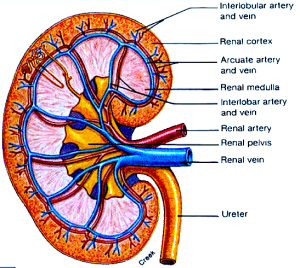You are here: Home1 / Fluoridation and Renal Disease in Aboriginal Communities
” … Since kidney damage can be caused by fluoride, there
can be a vicious circle by which kidney damage causes more
fluoride retention, which in turn causes further kidney damage… “
This is a hot issue – cover-up and denial is the ADA’s only option,
given the serious implications of fluoridation on millions of
kidneys both human and animal, including pets.




This is a Response to the American Dental Association’s Booklet –
‘Fluoridation Facts’
Extract:
Dr. Heyroth is a proponent for fluoridation yet, when testifying under oath at Congressional Hearings to the question: “Would you give fluoridated water to one with kidney trouble,” he answered, “No, the advice would be that he drink fluoride-free spring water.” (Dr. Francis Heyroth of Kettering Institute, Cincinnati, Ohio.)
” … Since kidney damage can be caused by fluoride, there can be a vicious circle by which kidney damage causes more fluoride retention, which in turn causes further kidney damage.” (Fredrick B. Exner, M.D., F.A.C.R.)
“Once renal function is severely impaired, the excretion of fluoride in the urine decreases and serum fluoride concentration increases.” (K. Kono, et al, Industrial Health, 22:33-40, 1984.)
“Many studies … have indicated suspicious bio-chemical events, especially in the kidneys, when consuming 1 ppm or more (up to 5 ppm in our study) fluoride ion in drinking water.” (Harold Warner, Professor Emeritus, Yerkes Regional Primate Center, Emory University, June 20, 1983.)
” … bear in mind that all elderly folk eventually have had one degree or another of ‘diminished renal (kidney) function’ and will accumulate higher tissue levels of fluoride at a time when their tolerance capacities are diminished.” (John R. Lee, M.D.)
“It would also seem prudent to monitor the fluoride intake of patients with chronic renal impairment … particularly those living in areas of high naturally occurring fluoride, children, those with excessive thirst, and those with prolonged disease.” (“Position Paper on Fluoride,” National Kidney Foundation, page 2, Aug. 16, 1980.)
“Sodium fluoride is a very toxic chemical. It reacts with growing tooth enamel and with bones to produce irreversible damage. It may injure the nervous system, kidneys and other tissues of susceptible individuals. Fluoride is not a necessary trace element for dental health. Uniform dosage of any drug dissolved in the water supply is obviously impossible. Some individuals may drink 10 times as much as others. Thirst has many variables.” (Dr. Granville F. Knight, (M.D., F.A.C., F.I.A.A.) Santa Barbara, California.)
“Until recently, I favored fluoridation of the City Water supply in the proportion of 1 ppm, but information provided me by Dr. C. C. Bass, Dean Emeritus of Tulane Medical School for the past 15 years (who has pursued research and study pertaining to teeth) along with some research done by British scientists indicating possible bad effects on the kidneys from fluoridation, has caused me to reverse my opinion on the matter.” (Dr. Alton Ochsner, President Ochsner Foundation Hospital and Head of Department of Surgery, Tulane University Medical School, New Orleans, Louisiana.)
“You are absolutely correct in stating that many people have diabetes but don’t know it. In the U. S., approximately half of the estimated 12 million people who have the disease don’t realize it … Diabetic care also depends on whether the individual suffers from complications associated with diabetes, such as kidney failure, coronary artery disease, etc. According to the National Institute of Dental Research, fluoride levels in water are set according to normal consumption of water. If an individual is consuming abnormally large quantities of water, he should drink bottled water.” (See 31-1: Department of Health and Human Services letter, Jan. 4, 1991). Nearly all diabetics and many athletes drink abnormally large quantities of water-many drink over a gallon a day. Therefore the Public Health Service is saying these people should buy bottled water.
“Because it can be documented that fluorides were given as medication for hyperthyroid patients, it should be considered the obvious cause for hypothyroidism and other thyroid-hormone function-related disorders, including ADHD, arthritis, osteoporosis, etc., especially at intake levels as high as they are.” (Thyroid Hormones, pp. 5, by Andreas Schuld, Parents of Fluoride Poisoned Children, PFPC., Vancouver, B.C., Canada.)
“Fluoride decreases the function of the thyroid gland by 30% to 40% and this is one of the most important glands in the body. In several parts of our country, children receive tablets with fluorine, but the fluoridation of drinking water has not been accomplished. We trust it will not happen in view of the special circumstances here regarding our thyroid problem. Research here demonstrates clearly an antagonism between iodine and fluorine. We also showed, in another experiment, that the calcium metabolism is greatly affected by fluorine. Since the bone picks up 30% less calcium in the presence of fluorine, the danger of osteoporosis in a growing organism is very great.” (Dr. T. Gordonoff, Professor of Pharmacology, Bern, Switzerland.)
“Long continued ingestion of minute quantities of fluorine causes disease of the thyroid gland.” (Dr. Douw G. Steyn, Department of Pharmacology, University of Pretoria, South Africa.)
“We have posted over 100 studies documenting the adverse effects of fluoride on the thyroid gland from the last 70 years or so in the Virtual Library on Fluoride Research at www.bruha.com.” (Andreas Schuld, Parents of Fluoride Poisoned Children (PFPC), Vancouver, B.C., Canada.)
“A fairly substantial body of research indicates that patients with chronic renal insufficiency are at an increased risk of chronic fluoride toxicity. These patients may develop skeletal fluorosis even at 1 ppm fluoride in the drinking water.”
(Dr. Helmut Schiffl, 2008) → HERE

→ Fluoride Risks Are Still A Challenge ←
Kidney patients and diabetics are at special risk from fluoridated water
because they tend to drink more liquid than healthy individuals…

Low Birth Weight and Reduced Renal
Volume in Aboriginal Children
Abstract:
Low birth weight predisposes to renal disease in Aboriginal adults. This could be due to reduced nephron numbers, which might be reflected in lower kidney volumes, at least early in life. In this study we evaluated the association of birth weight with renal volume in 174 children and in adolescents 5 to 18 years old in an Aboriginal community with high rates of renal disease. Their mean birth weight was 2.9 kg, and 19% had been low birth weight (<2.5 kg). Kidney dimensions were measured by ultrasound by a single observer, and kidney volume (KV) was calculated from the formula KV (mL) = length x (depth 1 + depth 2)/2 x 0.523. Combined kidney volume, corrected for body surface area (corrKV), was independent of age and averaged 240 +/- 45 mL/1.73 m(2). The average corrKV was significantly lower (by about 20 mL) in low birth weight children than in those with “normal” birth weight. There was a difference of 32 mL in combined corrKV between children in the lowest versus the highest quintile of birth weight. Disparities in calculated kidney volume were driven more by lower kidney depth than length in low birth weight children. We conclude that low birth weight children have lower renal volumes than children of higher birth weights, after correction for current body size. This conclusion is compatible with the theory that intrauterine growth retardation is associated with reduced nephron endowment. The susceptibility to renal disease associated with low birth weight in this population might be mediated in part through this mechanism.
-
PMID:
11325672
[PubMed – indexed for MEDLINE]

Call For Action to Combat Surge in Kidney Disease
Peter Munro
2 March 2008
CHRONIC kidney disease sufferers will double in number over the next decade unless the Government starts national preventive screening of high-risk groups, according to one of the world’s experts on the rampant “silent killer”.
Professor Allan Collins, president of the United States National Kidney Foundation, criticised the Government for not doing enough to combat the spread of the disease, which kills more than 40 Australians a day.
Speaking at a conference in Melbourne yesterday, he called for a national screening and early detection program to stem soaring rates of kidney failure.
“If you don’t do anything in the next 10 years you’re going to double the number of people on dialysis,” he said.
“The Government sort of hasn’t quite decided how to deal with it yet, and that’s a policy issue.”
Professor Collins said more than 500 million people worldwide, or about one in ten adults, had some form of kidney damage but most had no idea they were in danger.
“Nine out of 10 people don’t even know they have evidence of kidney disease,” he said. “There are no warning signs, which means it is vital that governments worldwide develop programs for the screening of patients in high-risk categories as part of their public health planning and strategies.”
About two million Australians are affected by kidney disease. The number needing treatment is growing by 6% a year and is expected to cost the health-care system more than $1 billion by 2010.
Anne Wilson, chief executive of Kidney Health Australia, said early detection could slow or stop the disease in up to 50% of cases. “It’s been the silent disease and governments have ignored it,” she said.
The Government has committed to a national preventive health strategy to tackle chronic disease, with an initial focus on alcohol, tobacco and obesity. But Ms Wilson said the Government needed to act now to stop the spread of chronic kidney disease.
“Right now Australia is behind the eight ball. The US Government is doing things about chronic kidney disease as part of a chronic disease strategy,” she said. “By comparison, Australia is falling behind and we need to address this as a matter of urgency.”
On March 13, World Kidney Day, Kidney Health Australia will test a group of people in Melbourne who are considered at high risk of chronic kidney disease as part of its pilot screening program.
High-risk groups include those aged 50-69, anyone who has diabetes, high blood pressure or a close relative with kidney disease, and anyone of Aboriginal or Torres Strait Islander descent.
Page 2
Professor Collins last week visited Olympic Dam mine at Roxby Downs in South Australia, where high-risk groups have been screened under a program funded by BHP Billiton and the [Aust.] Federal Government. People in Townsville have also been screened, with about a quarter of those tested showing signs of chronic kidney disease.
Dr Rowan Walker, kidney disease specialist at the Royal Melbourne Hospital, said the number of sufferers would rise further as a consequence of Australia’s ageing population. About 800 people are on dialysis at the hospital, just under half of the state’s total. “It’s a massive amount of cost for what is proportionately … a relatively small number of people,” said Dr Walker. What to watch for there are often no symptoms in the early stages of many kidney conditions. When symptoms do occur, the initial signs may be tiredness or generalised itching. As kidney disease progresses, the symptoms can include changes in the urine (reduced volume, discolouration, blood), nausea and appetite loss. Other symptoms include swollen or numb hands and feet, lethargy, darkened skin and muscle cramps.
Source: Kidney Health Australia



Scroll to top





